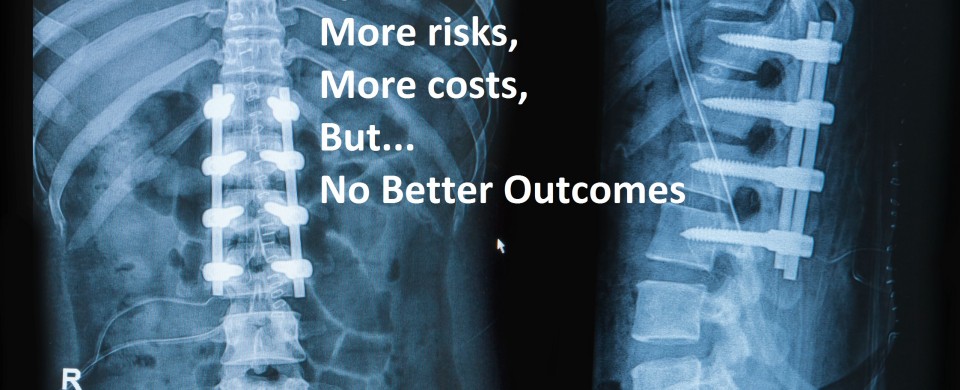Two decades ago lumbar spinal fusions were relatively rare. Most surgeries of the lumbar spine involved a decompressive laminectomy (removal of bone) without a fusion. But, over that time span, the rate of spinal fusions in the USA has increased at an alarming rate: a fifteen-fold increase between 2002 and 2007 alone. Now, almost half of all lumbar spine surgeries for spinal stenosis involve a fusion. This despite the fact that spinal fusion involves greater morbidity, longer operation time, longer hospital stay, and higher operation costs. Spinal fusions also have a high failure rate, with a significant number of patients remaining in severe pain or needing additional surgery. Spinal surgery involving fusion can cost 4-5 times more than a simple laminectomy. And that, may explain this explosion in the rate of fusions.
So, with this large increase in the rate of spinal fusions you would expect a significant body of evidence showing the superiority of fusion as compared to other treatments. But, that is not the case. As a matter of fac,t the latest medical evidence is showing quite the contrary: that spinal fusion is not particularly better than other forms of treatment.
Three years ago, this landmark study compared spinal fusion and non-operative treatment in patients with chronic low back pain: an average 11-year follow-up study found that patients with chronic low back pain and disc degeneration that elected to have spinal fusion surgery did no better than those who elected non-surgical care. The authors concluded that given the increased risks of surgery, the use of lumbar spine fusion in chronic low back pain patients should not be favored where other non-surgical treatments are available.
Now, a new study, published in the New England Journal of Medicine showed that adding a fusion to lumbar spine surgery for spinal stenosis did not result in better outcomes at 2 years, and 5 years. In this randomized controlled trial of almost 300 patients, the authors compared outcomes for a group of patients with spinal stenosis who underwent spinal surgery with no fusion against another group of patients who underwent spinal fusion. The authors found no benefits from fusion for spinal stenosis. Interestingly, this study also found a large failure rate in both groups, with 20-25% of patients undergoing a second surgery within 5 years. And this didn’t even include patients that remained in severe pain after the surgery, but did not elect to have another surgery.
An editorial on the same issue of this journal concluded that the addition of fusion to surgery in the treatment of lumbar spinal stenosis does not create any additional value and might be considered an unnecessary treatment. That is a big deal, an editorial opinion from the most influential medical journal in the world calling spinal fusion for lumbar spinal stenosis an unnecessary treatment.
If you suffer from chronic back pain, consider regenerative medicine as a safer alternative to surgery. Schedule a free consultation today to learn how regenerative treatment can help you manage your chronic back pain.
To learn more about non-surgical alternatives to back or joint surgeries go to: www.dontoperate.com .

